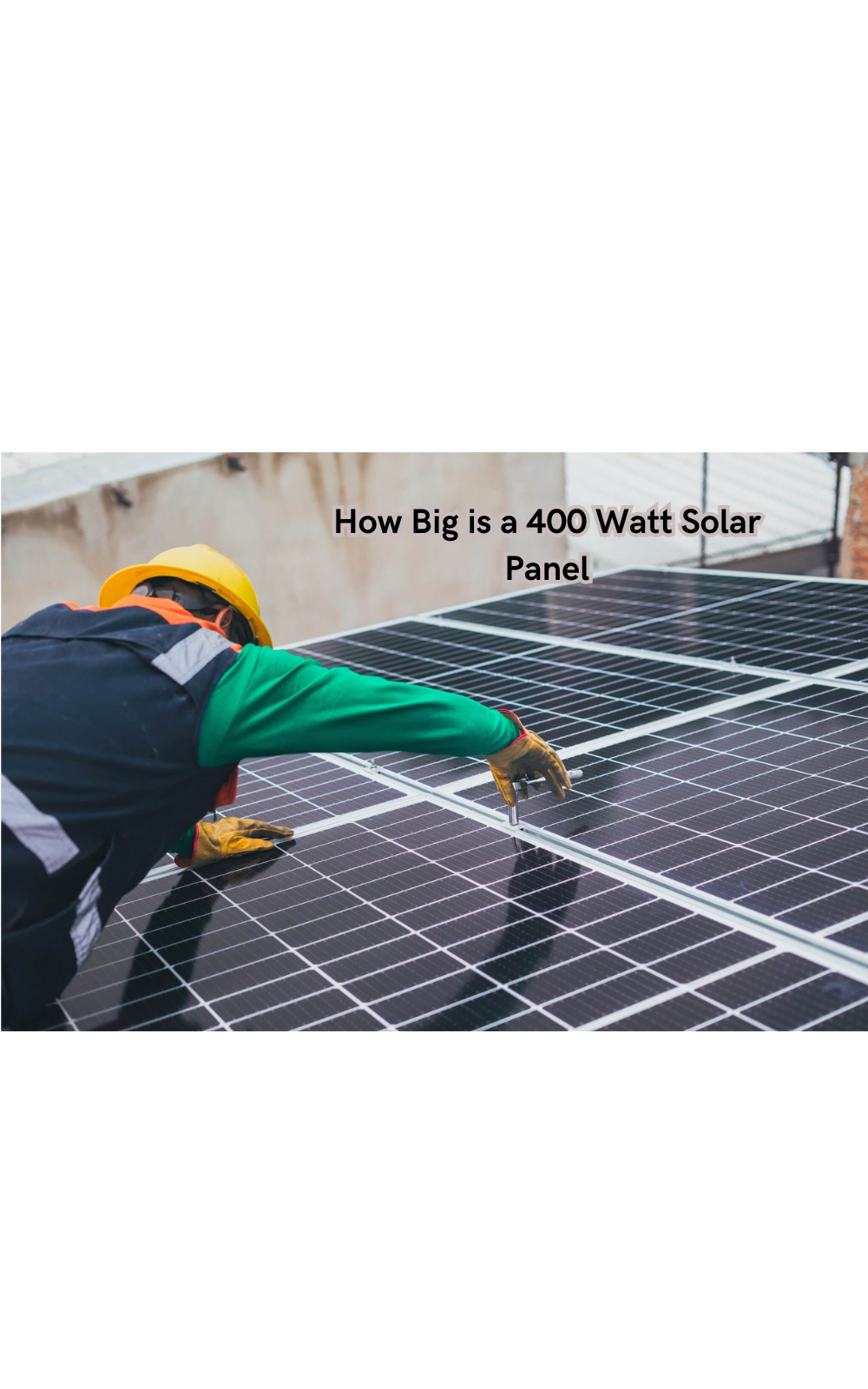How Big is a 400 Watt Solar Panel
Exploring the dimensions of a 400-watt solar panel provides insights into its compatibility with diff

The size of a 400-watt solar panel is a crucial factor in determining its installation feasibility and energy generation capacity. Understanding the physical dimensions of such a solar panel is essential for planning rooftop or ground-mounted solar arrays.
The size of a 400-watt solar panel can vary depending on the efficiency and design of the specific model. Factors like the type of solar cells used, the frame structure, and the technological advancements in the manufacturing process influence the overall dimensions of the panel.
Exploring the dimensions of a 400-watt solar panel provides insights into its compatibility with different installation spaces and its potential to harness solar energy efficiently. Let's delve into the specifics of the size of a 400-watt solar panel.
What is a 400-watt Solar Panel?
A 400-watt solar panel is a photovoltaic module that can produce 400 watts of power under standard test conditions. It typically consists of 72 solar cells connected in series and mounted on a sturdy frame with a protective glass cover.
These panels are commonly used in residential and commercial solar installations to generate electricity from sunlight.
They are designed to absorb the sun's energy and convert it into electricity that can power various electrical appliances and devices. Solar panel manufacturers often produce different wattage options, and a 400-watt solar panel is considered to be on the higher end of the spectrum.
Most solar panels available in the market today range from 250 to 400 watts, with some models even reaching up to 500 watts. How much power a solar panel can generate also depends on external factors such as sunlight availability, temperature, and shading.
Understanding the Dimensions of a 400-Watt Solar Panel
The standard dimensions of a 400-watt solar panel are approximately 78 inches by 39 inches by 1.4 inches (198 cm by 99 cm by 3.6 cm) in length, width, and height, respectively. However, these dimensions can vary slightly depending on the manufacturer and specific model.
The weight of a 400-watt solar panel is also an important consideration, with most panels weighing between 50 to 60 pounds (22 to 27 kg). The frame structure and mounting options may also contribute to the overall weight of the panel.
The size of a 400-watt solar panel is relatively larger compared to lower-wattage panels, as it has a higher number of solar cells and requires more space for optimum sunlight absorption. Therefore, it is important to factor in the size and weight of these panels when planning for installation. Solar panel sizes can also affect the overall cost, as larger panels may require additional support and mounting equipment.
How Big is a 400-Watt Solar Panel?
To put things into perspective, a 400-watt solar panel is roughly the size of a large flat-screen TV. This may seem like a significant space requirement, but it is important to note that these panels can produce enough electricity to power an entire household or commercial building.
The energy generation capacity of a 400-watt solar panel also makes it an ideal choice for off-grid and remote locations where traditional electricity sources may be unavailable or unreliable.
Solar power system designers and installers can provide expert guidance on the best placement and orientation of these panels to maximize their energy production potential.
Factors Affecting the Size of a 400-Watt Solar Panel
The size of a 400-watt solar panel is influenced by various factors, including the type of solar cells used and the frame design. Monocrystalline solar panels, which are made from a single crystal of silicon, are typically more efficient but also larger compared to polycrystalline panels.
Moreover, advancements in solar panel technology have led to the development of frameless panels that use back contact cells and a layer of adhesive material instead of a traditional frame. These panels are thinner and lighter compared to framed panels, which can contribute to their overall size and weight.
How Much Energy Does a 400-Watt Solar Panel Produce?
Now that we have explored the physical dimensions of a 400-watt solar panel let's take a look at its energy production capacity.
The amount of electricity generated by a 400-watt solar panel depends on various factors such as location, weather conditions, and installation angle. Lower-wattage solar panels may require more space to generate the same amount of electricity, making a 400-watt panel a popular choice for those with limited installation space.
On average, a 400-watt solar panel can produce anywhere between 1,200 to 1,800 kilowatt-hours (kWh) of electricity per year. This is enough to power essential household appliances like refrigerators, TVs, and lighting for a significant portion of the day.
Furthermore, different solar panel models may have varying efficiencies, which can also affect the energy output. The energy produced by a 400 W solar panel in different regions can also vary, with areas receiving more sunlight yielding higher energy production.
Benefits of a Compact 400-Watt Solar Panel
Though the size of a 400-watt solar panel may seem large, it offers several benefits that make it a popular choice among consumers.
- High Efficiency: A 400-watt solar panel can produce more energy compared to lower-wattage panels, making it an efficient option for generating electricity from sunlight. Monocrystalline solar panels, often known as mono solar panels, are considered to be the most effective, capable of converting 22% or more of sunlight into electricity.
- Space-Saving: Despite its higher wattage capacity, a 400-watt solar panel still maintains a compact size, allowing it to be installed in smaller spaces without compromising on energy production.
- Cost-Effective: Solar panels' cost per watt decreases; opting for a 400-watt panel can be a cost-effective choice in the long run as it generates more energy and requires fewer panels to meet energy needs. Solar equipment manufacturers also often offer warranties and performance guarantees for higher-wattage panels, providing additional cost savings.
How Much Does a Typical 400-Watt Solar Panel Cost?
The cost of a 400-watt solar panel can vary depending on factors like brand, efficiency, and installation location.
On average, a single 400-watt solar panel can cost anywhere between $200 to $500. However, it is essential to consider the overall savings in electricity costs over the panel's lifespan, making solar panels a wise investment for many consumers.
Furthermore, government incentives and rebates for renewable energy can also significantly reduce the cost of a 400-watt solar panel installation, making it a more affordable option.
Solar installations have also become increasingly accessible due to the rise of leasing and financing options. A solar panel produces electricity from sunlight while reducing the carbon footprint, making it a sustainable and eco-friendly energy source.
How many 400-watt Panels will I need for my Energy Needs?
The number of 400-watt solar panels needed for a home or commercial building depends on its energy consumption and location.
On average, a household in the United States consumes approximately 10,649 kWh per year, which would require around six to nine 400-watt solar panels to meet all their electricity needs. However, this number may vary depending on factors such as location, weather patterns, and the use of energy-efficient appliances.
Moreover, the use of energy storage solutions like batteries can also affect the number of panels needed, as excess energy can be stored for later use. Consulting with a solar professional and conducting an energy audit can help determine the appropriate number of 400-watt solar panels for your specific needs.
Best Practices for Installing Solar Panels
When it comes to installing a 400-watt solar panel, there are some best practices to keep in mind for optimal performance and safety. These include:
- Choosing the right location with unobstructed access to sunlight throughout the day. Ground mounted solar system options and rooftop installation can both be effective options. How much space is required for a 400-watt solar panel depends on the installation angle and orientation.
- Ensuring proper mounting and securing of panels to withstand weather conditions like wind and snow. Roof space may also be utilized for installation, but it is important to consult with a professional for safety and structural considerations.
- Regular maintenance and cleaning to maximize energy production.
- Following all local and national electrical codes for safe installation.
Solar panel options and technology continue to evolve, offering efficient and cost-effective solutions for renewable energy.
FAQs
How many kW is a 400W solar panel?
A 400W solar panel is equivalent to 0.4 kW. Solar panels are measured in watts, and a kilowatt (kW) is equal to 1000 watts.
Can I run my entire home on solar power with a 400-watt solar panel?
The number of panels needed for an entire home depends on various factors such as energy consumption, location, and efficiency. On average, a household in the United States consumes around 10,649 kWh per year, which would require approximately six to nine 400-watt solar panels to meet all electricity needs.
What can you run on a 400-watt solar panel?
A 400-watt solar panel can power essential household appliances such as refrigerators, TVs, and lighting for a significant portion of the day. However, energy production may vary depending on factors like location and weather conditions.
Is a 400-watt solar panel good?
Yes, a 400-watt solar panel is an efficient and cost-effective option for generating electricity from sunlight. It offers high efficiency, space-saving, and long-term cost savings compared to lower-wattage panels.
Conclusion
In conclusion, understanding the size of a 400-watt solar panel is pivotal for evaluating its practicality and optimizing solar energy systems. The physical dimensions of a solar panel directly impact its installation possibilities, efficiency, and power output. B
y considering the size of a 400-watt solar panel in relation to available installation spaces, one can determine the layout and configuration of solar arrays for maximum energy generation.
Additionally, advancements in solar technology continue to refine the design and efficiency of solar panels, influencing their size and weight.
